A subject is an observable that can multicast i.e. talk to many observers. Consider a button with an event listener, the function attached to the event using add listener is called every time the user clicks on the button similar functionality goes for subject too.
We are going to discuss the following topics in this chapter −
- Create a subject
- What is the Difference between Observable and Subject?
- Behaviour Subject
- Replay Subject
- AsyncSubject
Create a subject
To work with subject, we need to import Subject as shown below −
import { Subject } from 'rxjs';
You can create a subject object as follows −
const subject_test = new Subject();
The object is an observer that has three methods −
- next(v)
- error(e)
- complete()
Subscribe to a Subject
You can create multiple subscription on the subject as shown below −
subject_test.subscribe({
next: (v) => console.log(`From Subject : ${v}`)
});
subject_test.subscribe({
next: (v) => console.log(`From Subject: ${v}`)
});The subscription is registered to the subject object just like addlistener we discussed earlier.
Passing Data to Subject
You can pass data to the subject created using the next() method.
subject_test.next("A");
The data will be passed to all the subscription added on the subject.
Example
Here, is a working example of the subject −
import { Subject } from 'rxjs';
const subject_test = new Subject();
subject_test.subscribe({
next: (v) => console.log(`From Subject : ${v}`)
});
subject_test.subscribe({
next: (v) => console.log(`From Subject: ${v}`)
});
subject_test.next("A");
subject_test.next("B");The subject_test object is created by calling a new Subject(). The subject_test object has reference to next(), error() and complete() methods. The output of the above example is shown below −
Output
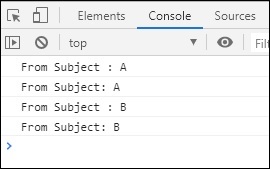
We can use complete() method to stop the subject execution as shown below.
Example
import { Subject } from 'rxjs';
const subject_test = new Subject();
subject_test.subscribe({
next: (v) => console.log(`From Subject : ${v}`)
});
subject_test.subscribe({
next: (v) => console.log(`From Subject: ${v}`)
});
subject_test.next("A");
subject_test.complete();
subject_test.next("B");Once we call complete the next method called later is not invoked.
Output
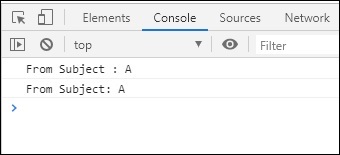
Let us now see how to call error () method.
Example
Below is a working example −
import { Subject } from 'rxjs';
const subject_test = new Subject();
subject_test.subscribe({
error: (e) => console.log(`From Subject : ${e}`)
});
subject_test.subscribe({
error: (e) => console.log(`From Subject : ${e}`)
});
subject_test.error(new Error("There is an error"));Output
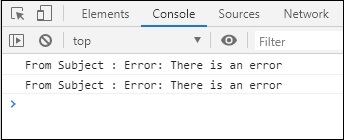
What is the Difference between Observable and Subject?
An observable will talk one to one, to the subscriber. Anytime you subscribe to the observable the execution will start from scratch. Take an Http call made using ajax, and 2 subscribers calling the observable. You will see 2 HttpHttp requests in the browser network tab.
Example
Here is a working example of same −
import { ajax } from 'rxjs/ajax';
import { map } from 'rxjs/operators';
let final_val = ajax('https://jsonplaceholder.typicode.com/users').pipe(map(e => e.response));
let subscriber1 = final_val.subscribe(a => console.log(a));
let subscriber2 = final_val.subscribe(a => console.log(a));Output


Now, here the problem is, we want the same data to be shared, but not, at the cost of 2 Http calls. We want to make one Http call and share the data between subscribers.
This will be possible using Subjects. It is an observable that can multicast i.e. talk to many observers. It can share the value between subscribers.
Example
Here is a working example using Subjects −
import { Subject } from 'rxjs';
import { ajax } from 'rxjs/ajax';
import { map } from 'rxjs/operators';
const subject_test = new Subject();
subject_test.subscribe({
next: (v) => console.log(v)
});
subject_test.subscribe({
next: (v) => console.log(v)
});
let final_val = ajax('https://jsonplaceholder.typicode.com/users').pipe(map(e => e.response));
let subscriber = final_val.subscribe(subject_test);Output

Now you can see only one Http call and the same data is shared between the subscribers called.

Behaviour Subject
Behaviour subject will give you the latest value when called.
You can create behaviour subject as shown below −
import { BehaviorSubject } from 'rxjs';
const subject = new BehaviorSubject("Testing Behaviour Subject");
// initialized the behaviour subject with value:Testing Behaviour Subject
Example
Here is a working example to use Behaviour Subject −
import { BehaviorSubject } from 'rxjs';
const behavior_subject = new BehaviorSubject("Testing Behaviour Subject");
// 0 is the initial value
behavior_subject.subscribe({
next: (v) => console.log(`observerA: ${v}`)
});
behavior_subject.next("Hello");
behavior_subject.subscribe({
next: (v) => console.log(`observerB: ${v}`)
});
behavior_subject.next("Last call to Behaviour Subject");Output
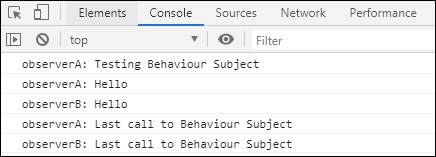
Replay Subject
A replaysubject is similar to behaviour subject, wherein, it can buffer the values and replay the same to the new subscribers.
Example
Here is a working example of replay subject −
import { ReplaySubject } from 'rxjs';
const replay_subject = new ReplaySubject(2);
// buffer 2 values but new subscribers
replay_subject.subscribe({
next: (v) => console.log(`Testing Replay Subject A: ${v}`)
});
replay_subject.next(1);
replay_subject.next(2);
replay_subject.next(3);
replay_subject.subscribe({
next: (v) => console.log(`Testing Replay Subject B: ${v}`)
});
replay_subject.next(5);The buffer value used is 2 on the replay subject. So the last two values will be buffered and used for the new subscribers called.
Output
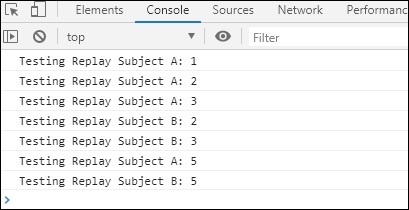
AsyncSubject
In the case of AsyncSubject the last value called is passed to the subscriber and it will be done only after complete() method is called.
Example
Here is a working example of the same −
import { AsyncSubject } from 'rxjs';
const async_subject = new AsyncSubject();
async_subject.subscribe({
next: (v) => console.log(`Testing Async Subject A: ${v}`)
});
async_subject.next(1);
async_subject.next(2);
async_subject.complete();
async_subject.subscribe({
next: (v) => console.log(`Testing Async Subject B: ${v}`)
});Here, before complete is called the last value passed to the subject is 2 and the same it given to the subscribers.
Output
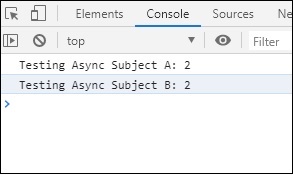
Leave a Reply